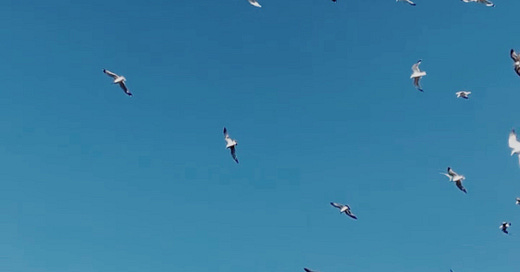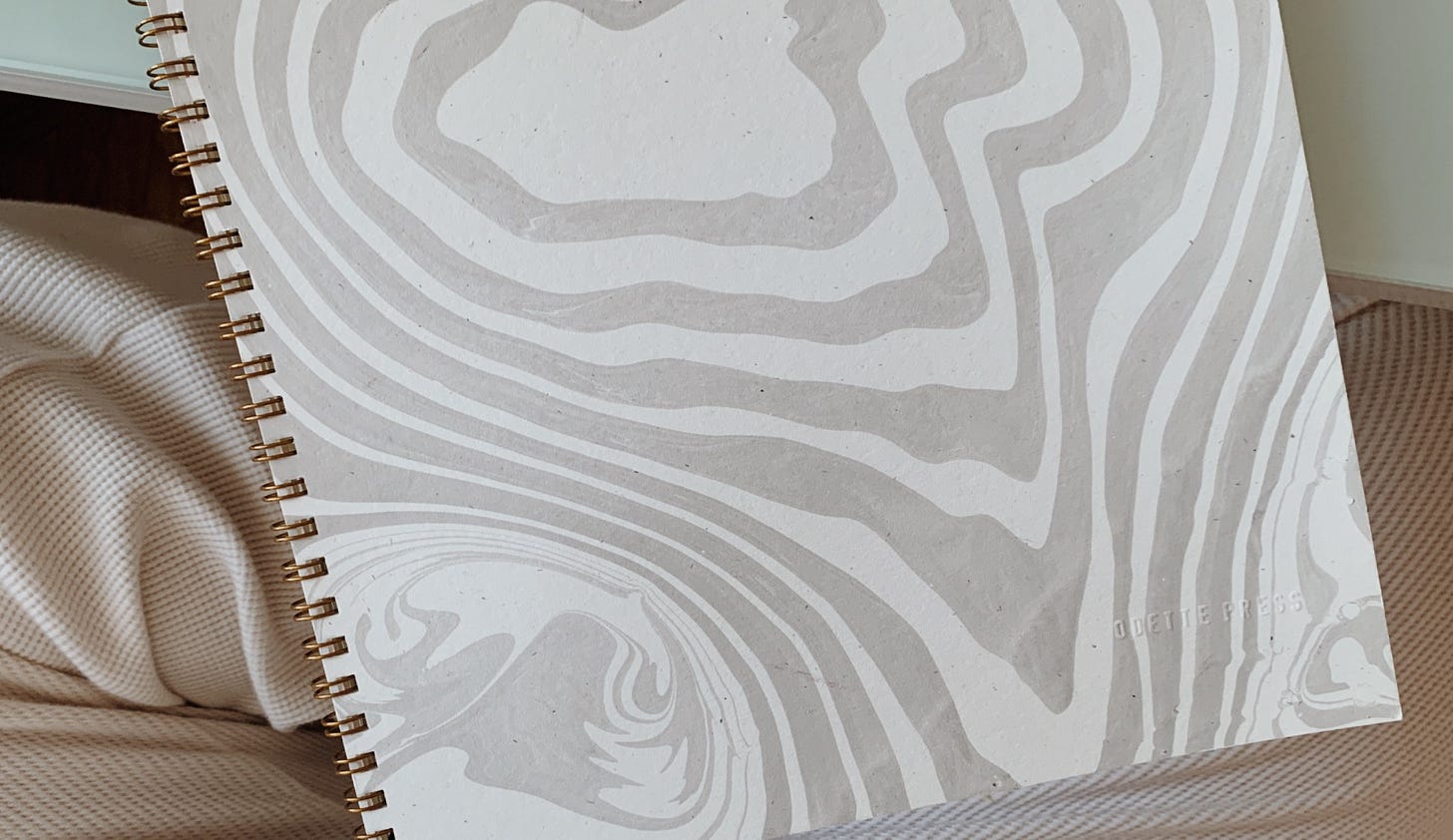I watch a map of birds migrating. Their migratory patterns shift in colors, bright across the screen as they land, showing their shifts back and forth from continent to continent, moving like a breath across the globe, moving from season to season. I find these patterns mesmerizing, and, like most times when I am tethered too deeply into a screen, I realize how I’ve barely waded into the depths of my lungs. Then: an exhale.
The breath shifts, and so do the seasons. So do the birds. So do we. Here we are in the almost spring. I am in a city of voices. There’s much to connect to and vocalize. The wind is moaning, the train screams past, music is playing in public spaces, crowds of voices are overlapping and they pass. Here, a city of protest and performance. Repetitions of bird calls contrast with computerized voices telling us the timetables, our next steps, and oncoming trains. Trains doors open and close, crowds shout, drinks clinking, pennies shaking in paper cups, car horns scream past, footsteps on the sidewalks, tuning into rhythm and timing of human pacing. We are running to catch the subway, our hearts racing, and then we exhale, slow the pace, settling.
There at the shoreline of the city I am listening to the wind, waves, hearing their gurgles, the fierce wind, watching it rip across the river, noticing the waves that rise up fast in the ferries’ departing. Wind merges with crowds of us waiting for the subways, makes its way into our apartments, through the seams of our windows, howling. Wind emerges from the depths of our beings, these human forms in feelings, giggling, enjoying, shouting, laughing. Voice is breath in the body emerging.
It is there with breath and body in the place where shoreline meets skyline where I think of exhaling. Winds, roaming fierce across the atmosphere, reveal shorelines in lower tides more exposed. Tides, in tandem with the wind, have pushed the water out further, so far out at low tide that the sand at the kayak landing is dried, making a pathway for the sunset curious and dogs and their walkers to roam around and wander. It’s ephemeral walkway. The edges of the water are farther from me than they’ve been, or that I can remember. Rocks, often covered over in high tide times, are bare to the sky from the wind. Over the weekend, in a class, we stood together around another water’s edge, this one smaller, playing with ink, water, expressing in breath, creativity and delight. Take a breath in, and then we exhale, letting the ink go where it goes, releasing control, tuning into the nature of wind, the nature of water.
I exhale slowly there in the sand and settle. I watch the the gulls and hear them shout. They are seeking food, floating, open wings on the wind. They ebb and flow with the air, riding high and low on the unseen, wind cooling and rising in pockets of heat. The birds sense the rise and fall of the air and use it to their advantage, flapping wings only to gather momentum upward when needed, or to leap off a landing place, away from some threats of prey and predation, floating out on the tethers of the wind. Tethered to the breath in their bodies, they call out, vocalizing expressions of need across the landscape.
Without realizing it, our bodies are always breathing. In this way, we are always expressing something. One of the many rhythmic systems within us that dance between automatic and conscious, breathing happens whether we turn our attention to it or not. When into the wind in the body, in meditation, in singing, in speaking, or focusing on the breath at the tip of the nose, we are condensing down and strengthening. The breath is there, always, sustaining us. Our bodies, these creative breathing instruments. They are beacons for language in all forms.
Whether externalizing voice, or tracing lines with your body across a space, you are breathing, supported by the atmosphere. Life living through you in the act of making. Let this be a pep talk to your creative parts: you are always creating and expressing something, connected through breath to the nature of this life.
At home, later, I am out of the throes of the wind. I conjure up thoughts about lyricism, poetics, sending messages out into circles of friends. We chatter through flutters of texts and calls in the threads of mornings and night. We are crepuscular, like the birds, each letting each other know we’ve made it through the days, the evenings. We speak to each other in songs, in tones, in pictures, memories of sunsets, connecting across time and land masses through these sonic, psychic bridges. These voices give shape and feeling to life through cadence, pace, and timbre.
I live alone, and I hum to myself often; this is a practice that helps me remember that I am here, in this body, and in this body I am home. I hum along, and I listen. I look to the birds, breath, wind, and atmospheres of life, and think of coming home to voice. How, in larger spheres of culture and conversations, the instruments of our voices are often played, or attempted to be played, twisted, contorted, or accessed by others often in the cases of race and gender. Tune into the ways in which we have been taught, then, to shift, sequester, change, or contort our own voices in order to perform, through pressures and expectations of inflections, of niceness, and presentations and performances of pleasantness. The ways that vocalization can be forced, feel foreign. It’s disorienting. Flattening. I find it exhausting.
Here’s what wind of the body — voice, expression, and breath — has taught me: that voices, in all their forms, are calls for creative force, connection, and communication, and that writing is one part of that creative process. Writing is a way of being with ourselves in the tender, strong, delicate, and intricate processes of being human, a way of cultivating solitude with ourselves, an inner sense of home within our own knowing. I know that when I am at home in the nature of myself I feel my voice deeper, in the basin of the stomach, expressed from a place that is sturdy, steady, and slow, unhurried, and that it moves freely to float on the winds of life as they rise and fall in true expression of the experience. That this resonance changes often when we are tired, untethered, scared, afraid, in love, in the flow, enraged, compassionate. That our voices emerge when we are in tune with our inner natures and bodies, connected. That harmonies and dissonance arise in life as parts of the nature of being. That like the gulls, we rise on these winds of life, then settle with the breath, and land. This is the process.
Voices spoken, painted, shouted, whispered, written, poetic or straightforward, written or embodied: these are our instruments. They are loud, soft, full, quiet, dynamic. They are evidence of our innate collaborations between thought and heart and feeling and need and urgent, emergent expression, a dance between timing and wind. Your voice is your tool and instrument. How can you tend to it?
I meditate wide on life, thinking broadly, and then return to breathing. The lens of life pans wide, then focusing in on the breath, warm and cool at the tip of the nose. Thinking, breathing, writing, being are tethered to the flow of these creative winds, the forces that we don’t see but feel regardless. Creative practice is a conversation, conversing with parts of ourselves and our pasts and our hopes, and horizons, our horizons with ourselves and each other, expression as a means to say, like the bird or train or the song I am protecting myself, I am connecting to you, I am feeling exuberant, I am feeling sadness, I am feeling anger and rage: listen, look, watch, I need this. Here I am, in this moment of existence.
Wind is the breath and the movement. It gathers momentum. It can slow our minds, whips us up, and brings us down. Think of running so hard and fast you reach an edge point, or whipping air into egg whites to peaks, or pausing to slow and gently gather threads of the mind, deep breaths to calm down. Think of seasons shifting, birds migrating, an inhale and exhale the same. Think of exhaling onto a flame to make it grow. I imagine creativity like a fire, and think about wind as a metaphor for motivation.
Think of the wind, the breath, and then feel it. Notice your own motivation, what feels like a fire in your life, like the wind, and what exhales on it. Breathe in deep, and slow. Exhale to completion. May we all breathe deep down, filling up wide with wise breath and possibility, then exhale, fast or slow, whatever is needed. May we move forward in the channels of our expressing. Notice: What pushes you forward? What fills you with breath, or depletes you? What’s your motivation?
nourished by, nourishing:
Thinking about vocal range and laughter watching Jenny Slate’s Seasoned Professional. Attempting to start most mornings with this breath track with David Elliott. Reading Pew by Catherline Lacey (more on Bookshop). Here’s a playlist for winding down, one I turn to at night, and one with more energy for the season ahead. Grateful for my students, the conversations we have in classes, and explorations into creative practice — paper and tools and ink were our ingredients this week. Delighted by soft sand, Friday night trains to the city, learning new places, thinking through food for the week, squares of chocolate, and a tart Austrian red.
I’m sharing some changes to the subscriber-only features later this month. More for spring and the seasons to come. Reminder that paid subscribers you’ll receive another seasonal session later this month.
classes and upcoming experiences:
Join in for creative practices with me in NYC and beyond:
3/14 Grounded in Gratitude
3/17 Build Your Journaling Practice
3/17 Bookbinding: Casing In Hardcovers
3/20 Taste + Write: Meditating on the Senses
3/26 Ink/Play
4/2 Creative Landscape [ a four week series] online
studio views:
Creative Nourishment is a reader-supported publication by Kelly Odette Laughlin. I’m an artist, writer, and teacher located in NYC, and the founder of Odette Press. I lead creative workshops throughout the city and beyond. Learn more about my work here, shop journals here. I’m glad you’re here.







